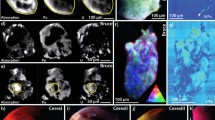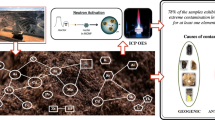Abstract
Runit Island on Enewetak Atoll was very heavily impacted by the U.S. nuclear testing campaign in the northern Marshall Islands (1946–58). The primary source of contamination on Runit Island was the 1958 Quince safety test where a large quantity of device plutonium (Pu) was scattered over the area near the GZ. A second low-yield device was detonated on the same site 10 days later, further disturbing the soil and leaving behind a very heterogeneous pattern of contamination including milligram-size particles of plutonium. A limited cleanup of the Fig-Quince zone was carried out in 1979. During this period, the effectiveness of the cleanup operations was primarily evaluated on the basis of bulk soil concentration data with little consideration given to the heterogeneity and long-term material-, biological-, and environmental-specific impacts of residual high activity (hot) particle contamination. The aim of the present study was twofold; (i) to characterize the levels and distribution of residual contamination in the Fig-Quince zone, and (ii) to develop pertinent data on the frequency distribution, elemental and isotopic composition, and physico-chemical properties of hot particles isolated from surface soils from Fig-Quince with a view towards providing recommendations on the future management and possible cleanup of the site. Today, Runit Island remains under an administrative quarantine.


Similar content being viewed by others
References
UNSCEAR (2000) Sources and effects of ionizing radiation. United States Scientific Committee on the effects of atomic radiation, UNSCEAR 2000 Report to the General Assembly, with Scientific Annexes, Vol 1: sources. United Nations, New York, 654 pp
Noshkin VE, Robison WL (2007) Health Phys 73:234
Hamilton TF (2004) Linking legacies of the cold war to arrival of anthropogenic radionuclides in the oceans through the 20th century. In: Livingston HD (ed) Marine radioactivity, vol 6. Elsevier Science, Amsterdam, pp 30–87
U.S. Department of Energy (1982) Enewetak radiological Support Project, Final Report. In: B Freisen (ed) U.S. DOE, Nevada Operations Office, NVO-213, Las Vegas, Nevada, pp 336–369
Davisson ML, Hamilton TF (2008) Report LLNL-TR-403015, Lawrence Livermore National Laboratory, 50 pp
Statcher JW, Ansoborilo E, Phipps AW (2000) Radiat Prot Dosimetry 92:201
Ansoborlo E, Statcher J (2000) Radiat Prot Dosimetry 92:139
Salbu B (2000) Radiat Prot Dosimetry 92:49
Salbu B (2008) Actinides in the environment. In: Kudo A (ed) Plutonium in the environment, vol 1. Elsevier, Oxford, pp 121–138
Betti M, Eriksson M, Jernström J, Tamborini G (2008) Analysis of environmental radioactivity. In: Povenic PP (ed) Radioactivity in the environment, vol 11. Elsevier, Oxford, pp 355–370
Madjoukov IG, Burns K, Madjoukova B, Vapirev EI, Tsacheva T (1992) Radiat Prot Dosimetry 40:235
Sadalls FJ, Segal MG, Victorva N (1993) J Environ Radioact 18:5
Dorrian MD (1997) Radiat Prot Dosimetry 69:117
Salbu B, Krekling T, Oughton D (1998) Analyst 123:843
Salbu B, Janssens K, Kreklin T, Oughton D (1999) Micro-X-ray absorption tomography and micro-XANES for characterization of fuel particles. http://www.esrf.fr/info/science/highlights/1999/chemistry/xanes.html
Cuddihy RG, Finch GL, Newton GJ, Hahn FF, Mewhinney JA, Rotenberg SJ, Powers DA (1989) Environ Sci Technol 23:89
Van Der Veen J, Van Der Wijk A, Mook WG (1996) Nature 323:399
Salbu B, Krekling T, Lind OC, Oughton DH, Drakopoulos M, Simionovici A, Snigirev I, Snigirev A, Weitkamp T, Adams F, Janssens K, Kashparov VA (2001) Nucl Instrum Methods Phys Res A 467–468:1249
Salbu B, Janssens K, Lind OC, Proost K, Danesi PR (2003) J Environ Radioact 64:167
Salbu B, Lind OC, Skipperud L (2004) J Environ Radioact 74:233
Jernström J, Eriksson M, Osán J, Tamborini G, Török Sz, Simon R, Falkenberg G, Alsecz A, Betti M (2004) J Anal At Spectrom 19:1428
Eriksson M, Osán J, Jernström J, Wegrzynek D, Simon R, Chinea-Cano E, Markowicz A, Bamford S, Tamborini G, Török Sz, Falkenberg GG, Alsecz A, Dahgaard H, Wobrauschek P, Streli C, Zeoger N, Betti M (2005) Spectrochim Acta Part B 60:455
Pöllanen R, Ketterer ME, Lehto S, Hokkanen M, Ikaheimonen TK, Siiskonen T, Moring M, Rubio Montero MP, Martin Sanchez A (2006) J Environ Radioact 90:15
Jernström J, Eriksson M, Simon R, Tamborini G, Bildstein O, Carlos Marquez R, Kehl SR, Hamilton TF, Ranebo Y, Betti M (2006) Spectrochim Acta Part B 61:971
Bielewski M, Eriksson M, Himbert J, Betti M, Falkenberg IG, Hamilton TF (submitted) Spectrochim Acta Part B
Martinelli RE, Hamilton TF, Williams RW, Kehl SR (this issue) J Radioanal Nucl Chem
Eriksson M, Ljunggren L, Hindorf C (2002) Nucl Instrum Methods Phys Res A 488:375
Simon R, Buth G, Hagelstein M (2003) Nucl Instrum Methods Phys Res B 199:554
Tamborini G, Betti M, Forcina V, Hiernaut T, Giovannone B, Koch L (1998) Spectrochim Acta Part B 53:1289
Defense Nuclear Agency (1981) The radiological cleanup of Enewetak Atoll. Washington DC, 700 pp
Robison WL, Noshkin VE, Hamilton TF, Conrado CL, Bogen KT (2001) Report UCRL-LR-143980. Lawrence Livermore National Laboratory, 21 pp
Eriksson M (2002) On weapons plutonium in the arctic environment (Thule, Greenland). Ph.D. Thesis, Risø-R-1321, Risø National Laboratory, Roskilde, Denmark, 146 pp
Shevchenko SV (2004) Appl Radiat Isot 61:1303
Bielewski M, Eriksson M, Himbert J, Simon R, Betti M, Hamilton TF (2007) Annual report of the synchrotron facility ANKA at the Forschungszentrum Karlsruhe, Germany, 2 pp
Acknowledgements
The Lawrence Livermore National Laboratory is operated by Lawrence Livermore National Security, LLC, for the U.S. Department of Energy, National Nuclear Security Administration under Contract DE-AC52-07NA27344.
Author information
Authors and Affiliations
Corresponding author
Rights and permissions
About this article
Cite this article
Hamilton, T.F., Jernströem, J., Martinelli, R.E. et al. Frequency distribution, isotopic composition and physical characterization of plutonium-bearing particles from the Fig-Quince zone on Runit Island, Enewetak Atoll. J Radioanal Nucl Chem 282, 1019–1026 (2009). https://doi.org/10.1007/s10967-009-0237-x
Received:
Accepted:
Published:
Issue Date:
DOI: https://doi.org/10.1007/s10967-009-0237-x




